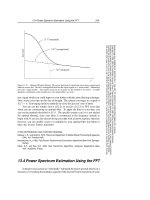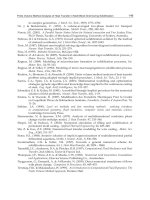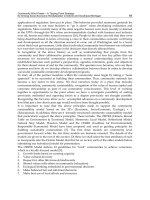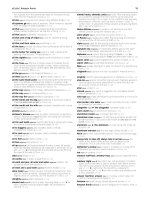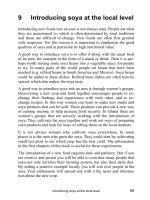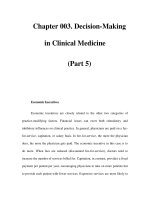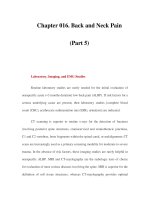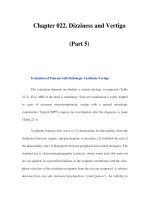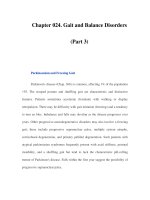Chapter 070. Nutritional Requirements and Dietary Assessment (Part 5) pptx
Bạn đang xem bản rút gọn của tài liệu. Xem và tải ngay bản đầy đủ của tài liệu tại đây (11.79 KB, 5 trang )
Chapter 070. Nutritional Requirements
and Dietary Assessment
(Part 5)
Physiologic Factors
Growth, strenuous physical activity, pregnancy, and lactation increase
needs for energy and several essential nutrients, including water. Energy needs
rise during pregnancy, due to the demands of fetal growth, and during lactation,
because of the increased energy required for milk production. Energy needs
decrease with loss of lean body mass, the major determinant of REE. Because both
health and physical activity tend to decline with age, energy needs in older
persons, especially those over 70, tend to be less than those of younger persons.
Dietary Composition
Dietary composition affects the biologic availability and utilization of
nutrients. For example, the absorption of iron may be impaired by high amounts of
calcium or lead; non-heme iron uptake may be impaired by the lack of ascorbic
acid and amino acids in the meal. Protein utilization by the body may be decreased
when essential amino acids are not present in sufficient amounts. Animal foods,
such as milk, eggs, and meat, have high biologic values with most of the needed
amino acids present in adequate amounts. Plant proteins in corn (maize), soy, and
wheat have lower biologic values and must be combined with other plant or
animal proteins to achieve optimal utilization by the body.
Route of Administration
The RDAs apply only to oral intakes. When nutrients are administered
parenterally, similar values can sometimes be used for amino acids, carbohydrates,
fats, sodium, chloride, potassium, and most of the vitamins, since their intestinal
absorption is nearly 100%. However, the oral bioavailability of most mineral
elements may be only half that obtained by parenteral administration. For some
nutrients that are not readily stored in the body, or cannot be stored in large
amounts, timing of administration may also be important. For example, amino
acids cannot be used for protein synthesis if they are not supplied together; instead
they will be used for energy production.
Disease
Specific dietary deficiency diseases include protein-calorie malnutrition;
iron, iodine, and vitamin A deficiency; megaloblastic anemia due to vitamin B
12
or
folic acid deficiency; vitamin D–deficiency rickets; scurvy due to lack of ascorbic
acid; beriberi due to lack of thiamine; and pellagra due to lack of niacin and
protein (Chaps. 71 and 72). Each deficiency disease is characterized by
imbalances at the cellular level between the supply of nutrients or energy and the
body's nutritional needs for growth, maintenance, and other functions. Imbalances
in nutrient intakes are recognized as risk factors for certain chronic degenerative
diseases, such as saturated and trans-fat and cholesterol in coronary artery disease;
sodium in hypertension; obesity in hormone-dependent endometrial and breast
cancers; and ethanol in alcoholism. However, the etiology and pathogenesis of
these disorders are multifactorial, and diet is only one of many risk factors.
Osteoporosis, for example, is associated with calcium deficiency as well as risk
factors related to environment (e.g., smoking, sedentary lifestyle), physiology
(e.g., estrogen deficiency), genetic determinants (e.g., defects in collagen
metabolism), and drug use (chronic steroids) (Chap. 348).
Dietary Assessment
In clinical situations, nutritional assessment is an iterative process that
involves (1) screening for malnutrition; (2) assessing food and dietary supplement
intake, and establishing the absence or presence of malnutrition and its possible
causes; and (3) planning for the most appropriate nutritional therapy. Some disease
states affect the bioavailability, requirements, utilization, or excretion of specific
nutrients. In these circumstances, specific measurements of various nutrients may
be required to ensure adequate replacement (Chap. 72).
Most health care facilities have a nutrition screening process in place for
identifying possible malnutrition after hospital admission. Nutritional screening is
required by the Joint Commission on Accreditation of Healthcare Organizations
(JCAHO), but there are no universally recognized or validated standards. The
factors that are usually assessed include abnormal weight for height or body mass
index (e.g., BMI <18.5 or >25); reported weight change (involuntary loss or gain
of >5 kg in the past 6 months) (Chap. 41); diagnoses with known nutritional
implications (metabolic disease, any disease affecting the gastrointestinal tract,
alcoholism, and others); present therapeutic dietary prescription; chronic poor
appetite; presence of chewing and swallowing problems or major food
intolerances; need for assistance with preparing or shopping for food, eating, or
other aspects of self care; and social isolation. Reassessment of nutrition status
should occur periodically in hospitalized patients—at least once every week.
A more complete dietary assessment is indicated for patients who exhibit a
high risk of malnutrition based on nutrition screening. The type of assessment
varies with the clinical setting, severity of the patient's illness, and stability of his
or her condition.
